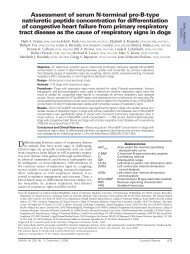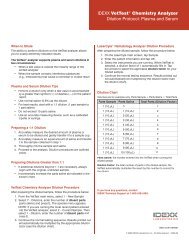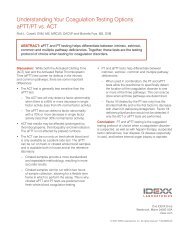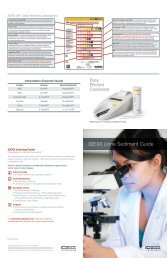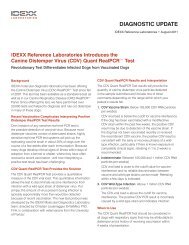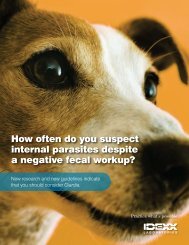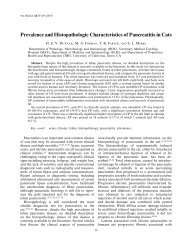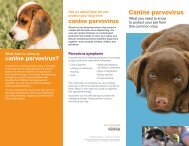The ABC's of Vector-borne Disease - IDEXX Laboratories
The ABC's of Vector-borne Disease - IDEXX Laboratories
The ABC's of Vector-borne Disease - IDEXX Laboratories
- No tags were found...
Create successful ePaper yourself
Turn your PDF publications into a flip-book with our unique Google optimized e-Paper software.
Client CommunicationHow to talk to clients aboutheartworm diseaseDetecting heartworminfection early generallyallows for a faster andmore effective response totreatment.Answers to pet owners’ mostcommonly asked questionsQ: Why should my dog be tested for heartworm disease?A: Transmitted by mosquitoes, heartworm disease has been found in dogs in all50 <strong>of</strong> the United States. Once a dog is infected, heartworm larvae begin tomature and enter the pulmonary arteries and heart. While heartworm is bothtreatable and preventable, it is a serious and deadly disease that shows no signsin its early stage.Q: How <strong>of</strong>ten should my dog be tested?A: Heartworm screening should be performed annually. Yearly tests ensure thatyour dog is heartworm-free and preventives are working. And if your dog isinfected, early detection can improve treatment outcomes. Also, heartwormpreventives are nearly 100% effective when administered properly, but dogson preventives sometimes test positive. <strong>The</strong>re are many reasons for this, andregular testing is the only way to accurately determine infection status.Q: What does it mean if my dog tests positive for heartworms?A: A positive result from an antigen test indicates with a high degree <strong>of</strong> certaintythat heartworms are in the pulmonary arteries or in the right chamber <strong>of</strong> thedog’s heart. Most dogs can successfully be treated if infection is detectedearly enough. If infection is not treated, disease will progress and eventuallycause death.Q: I forgot to give my dog preventative the last two months.Should I be worried?A: No, but you should resume preventive right away. Monthly preventives kill larvaethat may have accumulated in your dog’s body during the previous month. Andmost preventives have a retroactive “safety net” <strong>of</strong> one month that takes effectonce dosing is resumed. If the lapse in preventive is 3–6 months or more, restartas soon as possible and have your dog retested within 7–12 months.TAKE NOTEIt’s important to recognize the risk <strong>of</strong> your pet contracting heartworm disease.Here’s how:Put your dog on preventive and test annually:• Heartworm preventives are nearly 100% effective when administered properly.• Regular testing ensures your dog is heartworm-free and preventives are working.Watch for signs <strong>of</strong> heartworm disease, including:• Coughing (mild disease)• Coughing with exercise intolerance, abnormal lung sounds (moderate disease)• Above signs with difficulty breathing, temporary loss <strong>of</strong> consciousness, swelling<strong>of</strong> the abdomen, enlargement <strong>of</strong> the liver (serious disease)• Remember, early infection shows few if any signsTake your dog to the veterinarian regularly and include a screening testduring your dog’s next annual visit. For more pet health information,go to dogsandticks.com.© 2010 <strong>IDEXX</strong> <strong>Laboratories</strong>, Inc. All rights reserved. • 09-67079-00 • All ®/TM marks are owned by <strong>IDEXX</strong> <strong>Laboratories</strong>, Inc. or its affiliates in the United States and/or other countries. <strong>The</strong> <strong>IDEXX</strong> Privacy Policy is available at idexx.com.
T e a m E d u c at i o nHeartworm <strong>Disease</strong>Dir<strong>of</strong>ilaria immitis59% <strong>of</strong> dog-owninghouseholds in the U.S.administer heartwormpreventives. 1What is heartworm disease?Heartworm disease is a serious and potentially fatal condition caused by infectionwith the Dir<strong>of</strong>ilaria immitis parasite. Parasitic larvae are transmitted through the bite<strong>of</strong> a mosquito carrying the infective stage <strong>of</strong> heartworm. Heartworms mature andmigrate throughout the body, eventually inhabiting the arteries <strong>of</strong> the lungs andthe right side <strong>of</strong> the heart. While it can cause serious health issues, even death,heartworm is both treatable and preventable.Why is heartworm disease dangerous?Mature heartworms interfere with a dog’s blood flow and cause inflammation inand around the vessels <strong>of</strong> the heart. This can lead to a weakening <strong>of</strong> the heartmuscle, affecting the heart’s ability to pump blood. Other complications <strong>of</strong> thedisease include liver and kidney failure. Any one <strong>of</strong> more <strong>of</strong> these health issuesmay lead to death.What clinical signs should I watch for?Most dogs won’t show any sign <strong>of</strong> the infection during the early stages, making testingand preventives critical. Signs to watch for as the disease progresses include:• Coughing (mild disease)• Coughing with exercise intolerance, abnormal lung sounds(moderate disease)• Cough, exercise intolerance, dyspena (difficulty breathing), abnormal lungsounds, hepatomegaly (enlargement <strong>of</strong> the liver), syncope (temporary loss<strong>of</strong> consciousness due to poor blood flow to the brain), ascites(fluid accumulation in the abdominal cavity), abnormal heart sounds(serious disease)Are tests available for heartworm disease?<strong>The</strong>re are several heartworm antigen tests you can choose from, each with varyingdegrees <strong>of</strong> sensitivity and accuracy. Only the SNAP ® 4Dx ® Test gives you the ability toscreen four vector-<strong>borne</strong> diseases, including heartworm, with just one sample:• Canine anaplasmosis (Anaplasma phagocytophilum)• Lyme disease (Borrelia burgdorferi)• Canine ehrlichiosis (Ehrlichia canis)• Heartworm disease (Dir<strong>of</strong>ilaria immitis)Why is testing important?Heartworm infection <strong>of</strong>ten shows no signs in dogs in the early stages. Testing is theonly way to confirm infection status and determine whether treatment is necessary.Also, dogs on preventives sometimes test positive. Annual screening can help youdetermine if a patient is heartworm-free and whether preventives are working.It is estimated that more than 1 million dogs throughout theUnited States are currently infected with heartworms. 2References:1. Do you KNOW heartworms in cats?: new studies call for prevention & redefinition <strong>of</strong> heartworm disease in cats [news release].Orlando, FL: American Heartworm Society; January 14, 2007. www.heartwormsociety.org/inthenews/1-14-07.html. Accessed March 23, 2010.2. New canine heartworm guidelines released [news release]. Wilmington, DE: American Heartworm Society; February 15, 2010.www.heartwormsociety.org/inthenews/2-11-10.html. Accessed March 23, 2010.
Client CommunicationHow to talk to clients aboutcanine anaplasmosisDetecting canineanaplasmosis earlygenerally allows for afaster and more effectiveresponse to treatment.Answers to pet owners’ mostcommonly asked questionsQ: What is canine anaplasmosis?A: Canine anaplasmosis is a disease that can be transmitted to your dog by thedeer tick and the brown dog tick. <strong>The</strong>re are two forms <strong>of</strong> the disease that bothpose serious risks and can cause vomiting, diarrhea, and arthritis-like stiffnessand pain. Canine anaplasmosis is also a common companion infection, orcoinfection, with Lyme disease as the same types <strong>of</strong> ticks <strong>of</strong>ten carry the bacteriathat cause both infections.Q: Why should my dog be tested?A: We recommend regular testing, preferably on an annual basis, because manydogs won’t show any signs <strong>of</strong> disease for 21 days or more after initial infection.Regular testing gives us a chance to detect disease early, before serious signsappear, which has been shown to improve treatment and patient prognosis.Q: How can I protect my dog from infection?A: <strong>The</strong>re’s no available vaccine for canine anaplasmosis, but you can preventinfection by applying a tick-control product every month. Nothing will completelyprevent the possibility <strong>of</strong> infection, so it’s important to apply the product each andevery month to reduce your dog’s risk. Also, be sure to check your dog for ticksdaily and remove any attached ticks immediately.Q: How <strong>of</strong>ten should I have my dog tested?A: Screening for exposure to canine anaplasmosis should be incorporated as part <strong>of</strong>annual heartworm testing.Q: Can I get anaplasmosis from my dog?A: No, if your dog is infected with anaplasmosis, they cannot transmit it to you.However, the same tick that infected your dog can also transmit disease directlyto you or your family. It’s important to take preventative measures for yourself andyour family, including wearing protective clothing, performing frequent tick-checksand using tick-repellant products.TAKE NOTEIt’s important to recognize the risks <strong>of</strong> your pet contracting tick-<strong>borne</strong> diseases.Here’s how:Inspect your dog’s coat for ticks daily:• Feel for ticks or hard bumps.• Remove ticks immediately. For removal procedures, go to dogsandticks.com.Watch for signs <strong>of</strong> anaplasmosis infection, including:• Arthritis-like stiffness with painful joints• Fever accompanied by loss <strong>of</strong> appetite, vomiting and diarrhea• Lethargy and/or depression• Anorexia, weight loss• Neurological signs resulting in seizures and neck pain (infrequent)Take your dog to the veterinarian regularly and include a screening test during yourdog’s next annual visit. For more pet health information, go to dogsandticks.com.© 2010 <strong>IDEXX</strong> <strong>Laboratories</strong>, Inc. All rights reserved. • 09-67076-00 • All ®/TM marks are owned by <strong>IDEXX</strong> <strong>Laboratories</strong>, Inc. or its affiliates in the United States and/or other countries. <strong>The</strong> <strong>IDEXX</strong> Privacy Policy is available at idexx.com.
Detecting Lyme diseaseand canine anaplasmosiscoinfection early generallyallows for a faster andmore effective responseto treatment.Client CommunicationHow to talk to clients aboutLyme disease andcanine anaplasmosis coinfectionAnswers to pet owners’ mostcommonly asked questionsQ: What is Lyme disease and canine anaplasmosis coinfection?A: Ticks are able to transmit more than one disease-causing organism, whichcan result in multiple infections, or coinfection, in the same dog. Coinfectionwith Lyme and canine anaplasmosis is common as both diseases are spreadby the same type <strong>of</strong> tick, the deer tick (<strong>of</strong>ten referred to as black-legged tick).While Lyme and canine anaplasmosis can be very serious health threats on theirown, the combination <strong>of</strong> the two can pose significantly greater risk to your dog.Q: Why should my dog be tested?A: Coinfection with Lyme disease and canine anaplasmosis can be difficult todetect based on clinical signs alone. Testing is the only way to know for sureif your dog has been exposed. If they have been infected, testing can helpdetermine the best course <strong>of</strong> treatment for your dog’s individual health pr<strong>of</strong>ileand provide a benchmark for monitoring progress.Q: What does it mean if my dog tests positive for coinfection?A: Infection does not necessarily indicate disease and additional testing maybe required. If your dog does have active coinfection, there are a number <strong>of</strong>options to help treat and manage disease. And if infection is caught earlyenough, your dog will likely have a better response to treatment and animproved overall prognosis.Q: How can I protect my dog from infection?A: While vaccine is available to protect your dog from Lyme disease, there’sno available vaccine for canine anaplasmosis. You can help prevent infectionby applying a tick-control product every month. Nothing will completelyprevent the possibility <strong>of</strong> infection, so be sure to apply the product each andevery month. Also, be sure to check your dog for ticks daily and remove anyattached ticks immediately.TAKE NOTEIt’s important to recognize the risks <strong>of</strong> your pet contracting tick-<strong>borne</strong> diseases.Here’s how:Inspect your dog’s coat for ticks daily:• Feel for ticks or hard bumps.• Remove ticks immediately. For removal procedures, go to dogsandticks.com.Watch for signs <strong>of</strong> Lyme disease and canine anaplasmosis coinfection, including:• Arthritis-like stiffness with painful joints• Fever accompanied by loss <strong>of</strong> appetite, vomiting and diarrhea• Recurring lameness lasting 3–4 days with loss <strong>of</strong> appetite• Lethargy and/or depression; weight loss• Neurological signs resulting in seizures and neck pain (infrequent)Take your dog to the veterinarian regularly and include a screening testduring your dog’s next annual visit. For more pet health information, go todogsandticks.com.© 2010 <strong>IDEXX</strong> <strong>Laboratories</strong>, Inc. All rights reserved. • 09-67077-00• All ®/TM marks are owned by <strong>IDEXX</strong> <strong>Laboratories</strong>, Inc. or its affiliates in the United States and/or other countries. <strong>The</strong> <strong>IDEXX</strong> Privacy Policy is available at idexx.com.
T e a m E d u c at i o nCoinfectionLyme diseaseCanine anaplasmosisA study found that <strong>of</strong> 621naturally infected Lyme-positivecanine samples collectedfrom 2002–2004, 45.9% werealso positive for canineanaplasmosis. 1What is coinfection?When ticks are able to transmit more than one disease-causing organism,it can result in multiple infections, or coinfection, in the same dog. Lymedisease is caused by infection with the bacterium Borrelia burgdorferi, andcanine anaplasmosis is caused by Anaplasma phagocytophilum. In this case,the same types <strong>of</strong> tick carry both diseases: the deer or black-legged tick(Ixodes scapularis) and the western black-legged tick (Ixodes pacificus).Why is coinfection with Lyme disease andcanine anaplasmosis dangerous?It’s simple. When a dog contracts either Lyme disease or canine anaplasmosisalone, its immune system is more likely to suppress the disease. Dogs withseroreactivity to both B. burgdorferi and A. phagocytophilum may have twotimes the risk <strong>of</strong> developing clinical illness than singularly infected dogs. 2What clinical signs should I watch for?Associated clinical signs can mimic those <strong>of</strong> other tick-<strong>borne</strong> diseases,making it difficult to establish a diagnosis based on clinical signs alone.Dogs with clinical signs <strong>of</strong> Lyme disease and canine anaplasmosiscoinfection will likely present with the following:• Fever• Lethargy• Anorexia• Arthritis• Lameness• Swollen lymph nodesKeep in mind that coinfection may cause an animal to present with moresevere disease. Dogs with canine anaplasmosis may also present with red,swollen eyes and low platelet counts.Are tests available for coinfection?Yes. <strong>The</strong> SNAP ® 4Dx ® Test is the only in-house test that screensfour vector-<strong>borne</strong> diseases with just one sample:• Canine anaplasmosis (Anaplasma phagocytophilum)• Lyme disease (Borrelia burgdorferi)• Canine ehrlichiosis (Ehrlichia canis)• Heartworm disease (Dir<strong>of</strong>ilaria immitis)<strong>The</strong> SNAP 4Dx Test has also been shown to cross-react with A. platys.In a study by <strong>IDEXX</strong>, the SNAP 4Dx Test showed a positive result forA. phagocytophilum with serum from 10 <strong>of</strong> 10 dogs infected with a laboratorystrain <strong>of</strong> A. platys. 1Ticks can transmit more than one disease-causing organismto a dog, resulting in multiple infections, or coinfection.References:1. Data on file at <strong>IDEXX</strong> <strong>Laboratories</strong>, Inc. Westbrook, Maine USA.2. Beall MJ, Chandrashekar R, Eberts MD, et al. Serological and molecular prevalence <strong>of</strong> Borrelia burgdorferi, Anaplasmaphagocytophilum, and Ehrlichia species in dogs from Minnesota. <strong>Vector</strong>-Borne Zoonotic Dis. 2008;8(4):455–464.
CLIENT COMMUNICATIONHow to talk to clients aboutcanine monocytic ehrlichiosisDetecting the infection earlygenerally allows for a fasterand more effective responseto treatment.Answers to pet owners’ mostcommonly asked questionsQ: What does it mean if my dog tests positive for canine monocyticehrlichiosis?A: A positive result on the SNAP ® 3Dx ® Test or the SNAP ® 4Dx ® Plus Testmeans your dog has been exposed to Ehrlichia and may be infected withEhrlichia canis bacteria. Additional tests are needed to determine ifyour dog has an active infection requiring treatment.Q: Do people get this disease? Can I get it from my dog?A: No, you cannot get an E. canis infection from your dog. While it ispossible for people to be infected with other types <strong>of</strong> Ehrlichia bacteria,it is uncommon for an E. canis infection to occur in humans.Q: What is my pet’s health outlook now that he has been exposed?A: Exposure does not indicate active infection, and additional testing isneeded to determine whether or not treatment is required. Detecting theinfection early generally allows for a faster and more effective responseto treatment.Q: How <strong>of</strong>ten should I have my dog tested?A: Screening for exposure to E. canis should be incorporated as part <strong>of</strong>annual heartworm testing.Q: My dog was positive last year. What should I do this year?A: In areas where the brown dog tick is common, reexposure andreinfection are possible even in dogs with antibodies to E. canis. Basicblood work will help to identify dogs that are reinfected, and treatmentis only recommended for those dogs with evidence <strong>of</strong> active infections.TAKE NOTEIt’s important to recognize the risks <strong>of</strong> your pet contracting tick-<strong>borne</strong>diseases. Here’s how:Inspect your dog’s coat for ticks daily:• Feel for ticks or hard bumps.• Remove ticks immediately. For removal procedures, go todogsandticks.com.Watch for signs <strong>of</strong> E. canis infection, including:• Lameness, reluctance to move or exercise• Swollen or painful joints• Lack <strong>of</strong> energy or depression• Loss <strong>of</strong> weight or appetite• Vomiting, diarrheaTake your dog to the veterinarian regularly and include a screeningtest during your dog’s next annual visit. For more pet health information,go to dogsandticks.com.© 2011 <strong>IDEXX</strong> <strong>Laboratories</strong>, Inc. All rights reserved. • 09-69193-02 • All ®/TM marks are owned by <strong>IDEXX</strong> <strong>Laboratories</strong>, Inc. or its affiliates in the United States and/or other countries. <strong>The</strong> <strong>IDEXX</strong> Privacy Policy is available at idexx.com.
TEAM EDUCATIONCanine Monocytic EhrlichiosisEhrlichia canisCanine ehrlichiosis is thesecond most common infectionin the U.S. 1Reference:1. Hoskins JD. Seroprevalence <strong>of</strong> Ehrlichia in dogs. Vet Forum. 2000;18(10).What is canine monocytic ehrlichiosis?Sometimes referred to as tick fever, canine monocytic ehrlichiosis is causedby infection with Ehrlichia canis bacteria transmitted by the brown dog tick(Rhipicephalus sanguineus). Ehrlichia are gram-negative bacteria that infectand multiply in white blood cells (primarily monocytes).Why is canine monocytic ehrlichiosis dangerous?E. canis infection alters the dog’s ability to clot and puts a strain on thebone marrow where blood cells are produced. It can be fatal in both acuteand chronic forms. Over time, canine monocytic ehrlichiosis can cause thebone marrow to fail, resulting in a deficiency <strong>of</strong> red cells, white cells andplatelets. Dogs with more severe clinical signs resulting from canine monocyticehrlichiosis are typically more difficult to treat.What clinical signs should I watch for?Canine monocytic ehrlichiosis can be mild or severe, acute or chronic, withvarying clinical signs that include:• Discharge from eyes and nose• Depression and loss <strong>of</strong> appetite• Enlarged lymph nodes, spleen and liver• Muscle and joint pain, lameness• Bruising, nose bleeds or severe blood lossClinical signs can also be limited to changes in blood only, so it is importantto note that apparently healthy dogs with no outward signs could be infectedwith E. canis.Are tests available for canine monocytic ehrlichiosis?Yes, the SNAP ® 3Dx ® Test and the SNAP ® 4Dx ® Plus Test, simple, in-houseblood tests, can determine if a dog has been exposed to E. canis. However,additional tests, such as a complete blood count (CBC) and clinicalchemistry pr<strong>of</strong>ile, are needed to identify underlying abnormalities <strong>of</strong> infection.Polymerase chain reaction (PCR) tests may also be helpful in identifying anactive infection in sick dogs.Why should dogs be tested?Transmission <strong>of</strong> E. canis is common in the southern half <strong>of</strong> the United States.Dogs exposed to the brown dog tick are at risk for developing a chronicinfection, even if they appear outwardly healthy. Regular testing ensuresthat chronic infections won’t go undetected, potentially becoming moredifficult to treat.Can canine monocytic ehrlichiosis be prevented?Currently, there is no vaccine available for ehrlichiosis. Topical tick-controlproducts remain the key to preventing canine ehrlichiosis, as well asperforming regular tick checks. Controlling ticks in and around thehome can also minimize exposure to infection.Dogs exposed to the brown dog tick are at risk fordeveloping a chronic infection, even if they appear healthy.
CLIENT COMMUNICATIONHow to talk to clients aboutcanine granulocytic ehrlichiosisDetecting the infection earlygenerally allows for a fasterand more effective responseto treatment.Answers to pet owners’ mostcommonly asked questionsQ: What does it mean if my dog tests positive for caninegranulocytic ehrlichiosis?A: A positive result on the SNAP ® 4Dx ® Plus Test means your dog has beenexposed to Ehrlichia and may be infected with Ehrlichia ewingii bacteria.Additional tests are needed to determine if your dog has an activeinfection requiring treatment.Q: Do people get this disease? Can I get it from my dog?A: No, you cannot get an E. ewingii infection from your dog. <strong>The</strong> lone startick can transmit E. ewingii to people and, more significantly, Ehrlichiachaffeensis, the causative agent <strong>of</strong> human monocytic ehrlichiosis.Q: What is my pet’s health outlook now that he has been exposed?A: Exposure does not indicate active infection, and additional testing isneeded to determine whether or not treatment is required. Detecting theinfection early generally allows for a faster and more effective responseto treatment.Q: How <strong>of</strong>ten should I have my dog tested?A: Screening for exposure to E. ewingii should be incorporated as part <strong>of</strong>annual heartworm testing.Q: My dog was positive last year. What should I do this year?A: In areas where the lone star tick is common, reexposure and reinfectionare possible even in dogs with antibodies to E. ewingii. Basic blood workwill help to identify dogs that are reinfected, and treatmentis only recommended for those dogs with evidence <strong>of</strong> active infections.TAKE NOTEIt’s important to recognize the risks <strong>of</strong> your pet contracting tick-<strong>borne</strong>diseases. Here’s how:Inspect your dog’s coat for ticks daily:• Feel for ticks or hard bumps.• Remove ticks immediately. For removal procedures, go todogsandticks.com.Watch for signs <strong>of</strong> E. ewingii infection, including:• Lameness, reluctance to move or exercise• Swollen or painful joints• Lack <strong>of</strong> energy or depression• Loss <strong>of</strong> weight or appetiteTake your dog to the veterinarian regularly and include a screeningtest during your dog’s next annual visit. For more pet health information,go to dogsandticks.com.© 2011 <strong>IDEXX</strong> <strong>Laboratories</strong>, Inc. All rights reserved. • 09-79989-00 • All ®/TM marks are owned by <strong>IDEXX</strong> <strong>Laboratories</strong>, Inc. or its affiliates in the United States and/or other countries. <strong>The</strong> <strong>IDEXX</strong> Privacy Policy is available at idexx.com.
TEAM EDUCATIONCanine Granulocytic EhrlichiosisEhrlichia ewingiiCanine ehrlichiosis is thesecond most common infectionin the U.S. 1What is canine granulocytic ehrlichiosis?Canine granulocytic ehrlichiosis is caused by infection with Ehrlichia ewingiibacteria transmitted by the lone star tick (Amblyomma americanum). Ehrlichiaare gram-negative bacteria that infect and multiply in white blood cells(predominantly neutrophils).Why is canine granulocytic ehrlichiosis dangerous?Infection with E. ewingii may lead to a decrease in the dog’s platelets, whichare important in the formation <strong>of</strong> blood clots, and the infection may producemarked joint pain or central nervous system signs.What clinical signs should I watch for?Canine granulocytic ehrlichiosis can be inapparent, mild or severe andtypically acute, with varying clinical signs that include:• Depression and loss <strong>of</strong> appetite• Weight loss• Joint pain, lameness• Head tilt or tremorsClinical signs can also be limited to changes in blood only, so it is importantto note that apparently healthy dogs with no outward signs could be infectedwith E. ewingii.Are tests available for canine granulocyticehrlichiosis?Yes, the SNAP ® 4Dx ® Plus Test, a simple, in-house blood test, can determineif a dog has been exposed to E. ewingii. However, additional tests, such asa complete blood count (CBC) and clinical chemistry pr<strong>of</strong>ile, are neededto identify underlying abnormalities <strong>of</strong> infection. Polymerase chain reaction(PCR) tests may also be helpful in identifying an active infection.Why should dogs be tested?Transmission <strong>of</strong> E. ewingii is common in the south central and southeasternportions <strong>of</strong> the United States. Dogs exposed to the lone star tick are at riskfor developing an infection, even if they appear outwardly healthy. Regulartesting ensures that persistent or recurrent infections won’t go undetected.Can canine granulocytic ehrlichiosis beprevented?Currently, there is no vaccine available for ehrlichiosis. Topical tick-controlproducts remain the key to preventing canine ehrlichiosis, as well asperforming regular tick checks. Controlling ticks in and around thehome can also minimize exposure to infection.Dogs exposed to the lone star tick are at risk <strong>of</strong> harboringa persistent infection, even if they appear healthy.Reference:1. Hoskins JD. Seroprevalence <strong>of</strong> Ehrlichia in dogs. Vet Forum. 2000;18(10).



